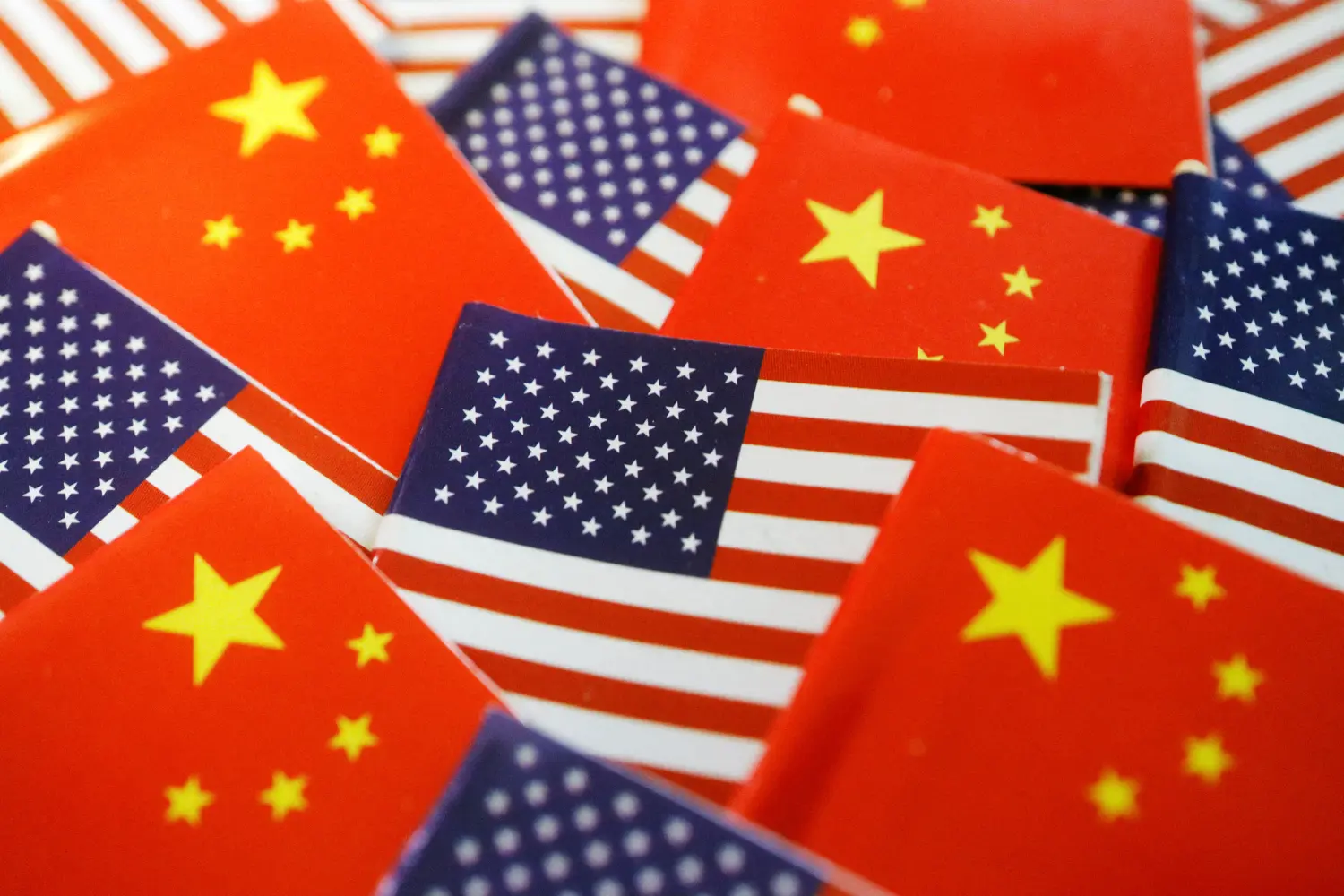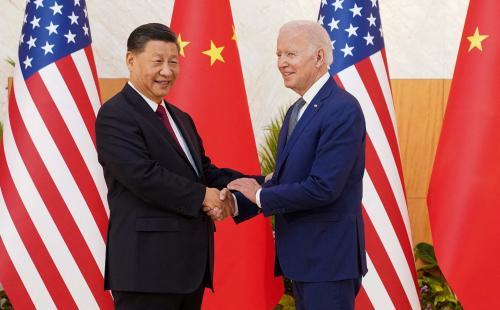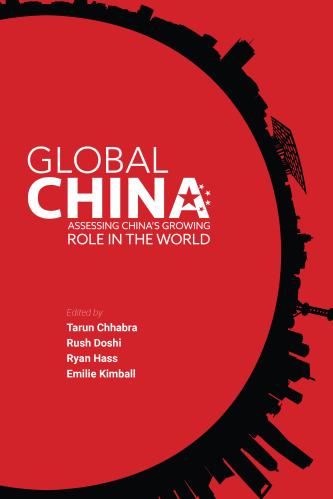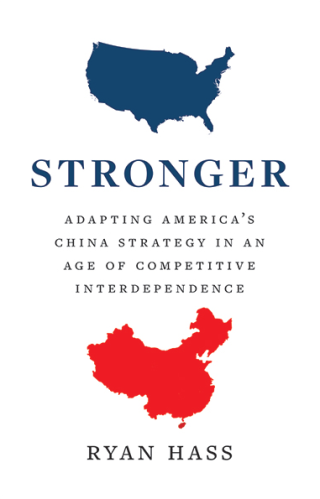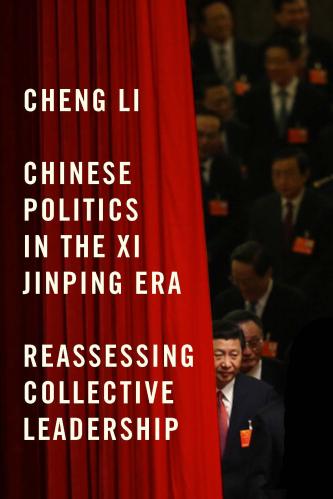America’s increasingly hardline China policy is probably 80% right on its specific components, given Beijing’s assertiveness of recent years, but it is at risk of going too far in its tone and temperature. While staying focused on the challenges posed by China’s rise, it is crucial that we keep our strategic composure and sense of perspective on the nature of the problem. America is capable of groupthink, as we arguably saw for example in the Vietnam War and in the prelude to the Iraq invasion of 2003. We need to avoid the temptation to unify so strongly around the China threat paradigm that we unwittingly increase the risks of confrontation ourselves. That could happen if Washington inadvertently signaled support for Taiwan’s de jure independence and a willingness to fight China on its behalf upon such a declaration. It could also happen if the United States overreacted to a relatively minor and non-lethal incident in the South China Sea or East China Sea, or if the two countries demonized each other to the point that communications between them were largely cut off even when badly needed during a future crisis.
Whether it is China’s record on the use of force, its stated and revealed aspirations for expanded global influence in the future, or its ongoing military buildups, Beijing poses real challenges to American strategic interests. But the situation, while potentially dangerous, is not dire. It is not comparable to Adolf Hitler’s rise in the 1930s, or Josef Stalin and Mao Zedong’s ambitions of the 1940s and 1950s — and despite the injudicious use of this term by seasoned foreign policy experts in a recent influential article, China does not together with Russia and Iran constitute a “new axis of evil.” For example, while growing fast, China’s military budget totals one-third of America’s (roughly speaking) and only about half as high a fraction of the nation’s gross domestic product, and China has not fought a war since 1979. Vigilance is needed; resoluteness is required; pushback is essential. But so is calm, and a sense of proportionality.
The United States is doing a generally good job in standing up to a rising China. Strong bipartisan consensus for an $858-billion U.S. national defense budget in 2023, exceeding peak levels of Cold War resources in inflation-adjusted terms, bodes well. So do recent bipartisan decisions to strengthen America’s technological and industrial foundations in key sectors here at home through the CHIPS and Science Act, so-called Inflation Reduction Act, and Infrastructure Investment Act, as well as a generally more supportive approach to education in the STEM fields of science, technology, engineering, and mathematics in recent times. The United States and its allies are rightly using tools like the Committee on Foreign Investment in the United States to limit China’s ability to acquire, and exploit, this and allied nations’ high-tech jewels. American and allied militaries continue to conduct freedom of navigation exercises in the Western Pacific region even where China wrongly claims they should not; the United States rightly seeks to improve Taiwan’s military capacities against possible Chinese attack, even if the pace of that effort often lags.
We risk taking actions that could help turn a rival into an adversary or even a military enemy.
But we may be on the verge of overdoing it — if not in the specifics of our policy responses to China’s rise, then in the overall mindset of how to handle the People’s Republic of China (PRC). We risk taking actions that could help turn a rival into an adversary or even a military enemy.
To be sure, China is not only a challenge but a potential danger, and its foreign policy behavior during the last decade has been particularly fraught. Its military capacities are already impressive enough that for many types of hypothetical conflicts pitting America and its allies against China, it is not clear which side would win — a reality that should concern civilian strategists and military planners alike.
Thus, I agree with 80% to 90% of specific U.S. policies that focus on addressing that threat. But the last 10% to 20% (notionally speaking) may be on the verge of going too far. So does the framing rhetoric and language we now often collectively use to describe China. Such thinking could lead, for example, to excessively rapid escalation in a crisis, especially if we convince ourselves that China has a specific plan to attack Taiwan by a certain date this decade. It could also lead the United States, very dangerously, to abandon the “One China” policy that has helped prevent war over Taiwan for four decades.1
Much of this paper is written, accordingly, as a provocation, or at least an attempt at a corrective to the trend in current U.S. strategic thought.2 It is not my own effort to mimic the worldwide threat assessments that the Director of National Intelligence or Defense Intelligence Agency produce each winter. Instead, this is an interpretative essay about what we are getting right, and what we perhaps are not, in what is quickly becoming a new collective wisdom in the United States about the nature of the China threat in particular.
The essay is my second of three over the 2022-2023 period that offer guidance for U.S. defense strategy as well as the defense budget. The first, also published by The Brookings Institution in 2022, was entitled “Can China take Taiwan? Why no one really knows.”3 It consisted largely of a detailed modeling of a potential Chinese naval blockade of Taiwan followed by a U.S./Taiwan/allied response. It reached the conclusion noted above, as stated in the title of the paper: for a number of types of possible U.S.-China engagements, it is unrealistic to think we can predict the winner. That is true, I believe, even assuming that policymakers prevent any such war from escalating geographically or vertically (e.g., to nuclear weapons employment). The conclusion, I find, is also relatively impervious to the specific size or cost of the U.S. defense establishment. Thus, when I argue that we should rightsize and not overestimate the China threat, I do not mean to suggest that America enjoys an overwhelming military advantage against the PRC for all the kinds of contingencies that could pit the two countries against each other. Rather, I contend that the depiction of China as a fundamentally hostile and aggressive nation is often overdone in the contemporary American strategic debate.
The final paper of my “trilogy,” to be published late in 2023, has the working title of “A Trillion Dollars for Defense? Slightly Too Much of a Good Thing.” It will provide specific suggestions on where and how economies, as well as necessary increases, can be made in the U.S. defense program of today. This paper attempts to lay the foundation for that final paper by analyzing the strategic environment in which defense policy and defense budgets are made.
For some, the rise of China poses an inordinate risk to the global order. Graham Allison, a brilliant Harvard strategist and historian, has coined the phrase “Thucydides Trap” to underscore the risks when a rising power challenges an existing and established rival. It is worth remembering that, in the case of Greek city-states, it was a rising democracy, Athens, that was seen as threatening by an established and less democratic Sparta — a different dynamic than the one between China and the United States today. In the specific case of China, we face an autocratic regime brimming with confidence, a strong desire to bring Taiwan back under its rule, and substantial ambitions in the Western Pacific, broader Middle East, and beyond. China wields the world’s largest manufacturing base, second-largest economy by traditional exchange-rate measures, largest economy when adjusted for purchasing power parity, and impressive technological capabilities including in crucial digital and cyber sectors. It now has the world’s second-largest population, next to India.4
Allison is right to warn in general terms about what such big changes have meant historically. But there is so much different about today’s world — to repeat, the preponderance of democracies (despite recent setbacks, a far higher percentage of the world’s population now lives in countries deemed free or partly free by Freedom House than at any time before the Cold War’s end), the strength of the modern U.S.-led alliance system, forward-stationed American military forces to undergird those alliances, nuclear deterrence, some aspects of globalization — to give considerable reason for hope that past patterns in great-power relations can be changed. Arguably, since 1945, they already have been, despite the partial backsliding in recent years.5
The Biden administration’s National Security Strategy prioritizes China as the “most consequential geopolitical challenge” of the United States,6 and its National Defense Strategy designates the PRC as America’s “pacing challenge.”7 These are reasonable terms. They have led the Biden team, like the Trump team before it, to increase defense spending; emphasize military innovation and modernization within the defense budget; seek to address national vulnerabilities in the cyber, space, and infrastructural domains; prioritize the Pacific region in national security terms; and undertake a number of key initiatives to that same end with major allies and partners. All of this is to the good. None of it was easy or automatic. None is guaranteed to endure unless we stay appropriately vigilant.
There is vigorous debate in the United States over whether Beijing might see a window of opportunity to attack Taiwan by the late 2020s. The former head of U.S. Indo-Pacific Command, Admiral Philip Davidson, has warned of that possibility.8 Secretary of State Antony Blinken had concluded by October of 2022 that China had become “…determined to pursue reunification on a much faster timeline…”9 Chinese President Xi Jinping has told his military to be fully modernized and ready for all contingencies by 2027.10 Some strategists also believe that, in light of its demographic decline and other internal challenges that could get much worse by the 2030s, China may perceive itself to have a relatively narrow window of opportunity to take Taiwan in the late 2020s or so.11 It is true that China faces long-term economic and environmental challenges that are quite significant.12 By 2050, it will have 500 million individuals over 60 but only 700 million workers to provide for them; by 2100, given current predictions, its population may have declined from 1.4 billion to 800 million. Those trends may augur well for China in the 22nd century if it can stabilize its population sometime in that period — but in the shorter term, such demographics pose huge challenges to any government.13
The idea that any military can ever complete a full modernization program by a certain date is never quite plausible; military innovation is always ongoing and continuous in the real world.
But despite these challenges, I see little evidence that Chinese leaders lack confidence in their country’s long-term future. And as for Xi’s promulgation of a 2027 deadline for modernization, his language may be mostly hortatory. The idea that any military can ever complete a full modernization program by a certain date is never quite plausible; military innovation is always ongoing and continuous in the real world.14 Thus, some scholars, while hardly downplaying the China threat, tend to view it as a more general and lasting problem as opposed to an acute challenge in a given window of time.15 The chief of staff of the U.S. Air Force has a similar view.16 I lean toward this latter interpretation myself, largely because China is in the business of issuing various kinds of five-year, ten-year, and other plans — not all of which have specific military implications and not all of which are realistic. Notably, Beijing’s “Made in China 2025” plan, promulgated back in 2015, calls for China to be a leader in 10 high-tech sectors, including a number like robotics with major military relevance, by the year 2025; other plans focus on 2030 or 2035, or aspire to major changes by the 100th anniversary of Chinese Communist Party rule in China in 2049.17
What about the Russian threat? We must not lose sight of that challenge — as General H.R. McMaster and Secretary of Defense James Mattis rightly underscored in the Trump administration’s National Security Strategy of 2017 and National Defense Strategy of 2018. It is Russia, after all, that is laying waste to cities in Europe and issuing nuclear threats against the West even as these words are written; it is Russian President Vladimir Putin who seems to have a pathological hatred of all things Ukrainian, especially its (admirable) leader, Volodymyr Zelenskyy, and a contempt for the idea that there even should be such a thing as an independent Ukrainian nation.18 Ironically, Putin’s aggressions against Ukraine may have done more to unify and cohere its people, and stoke their sense of distinctiveness as well as nationalism, than anything else in their history.19 And Putin continues to act on these sentiments, with little evidence that what is left of Russian democracy can exert any meaningful checks and balances on his behavior. Putin has also spent two decades building up resentment against the West — over NATO and European Union expansion, the Kosovo war, American support for “color revolutions” in Ukraine and Georgia in the early 2000s, American support for some of Putin’s political opponents at home, and what Putin sees as unilateralist American blundering from Iraq to Afghanistan to Libya after 9/11.
Putin has spent recent years in Russia further marginalizing his internal critics and weakening, if not ending, his country’s democracy.20 Alas, the history of leaders like Putin around the world hardly suggests that he will likely leave office soon — or that his regime will be replaced by a more democratic and benign political system once gone.21
Some have described Russia as a regional power with nuclear weapons, as a giant gas station, or as some other such derogatory term. Although it is true that Russia’s GDP is comparable to that of a mid-level Western European power, and that its scientific and technological capacity has atrophied (even before the sanctions of 2022), it is hardly to be trifled with.22 It is the world’s top nuclear weapons state, the world’s largest country in terms of landmass, the world’s most geographically exposed and yet geographically menacing country (those two attributes being flip sides of the same coin), and a proud nation with a strong sense of national identity and global purpose. It has more than three times the population of Iraq or Afghanistan (or Ukraine). Moreover, in its near abroad, it is highly motivated and reasonably powerful — a combination that Kathryn Stoner convincingly argues gives it considerable power and influence in some key parts of Europe.23
All that said, I believe we have most of the makings of a successful Russia policy today. Supporting Ukraine strongly in its war effort, sustaining sanctions on Russia, and fortifying NATO’s eastern flank provide the raw ingredients for a successful Russia policy in the months and years to come — provided we stay focused, vigilant, and united, and also creative as well as pragmatic in thinking through ways the war in Ukraine can eventually end.24
It will be entirely fair game if a GOP House of Representatives asks for more accountability and more answers to tough questions about the end game for the war in Ukraine, as it considers future Biden administration requests for aid for Ukraine. But such questioning must not actually interrupt the flow of crucial assistance or smack of irresoluteness on our collective part. Provided we get that balance right, and think creatively about that end game in Ukraine, I believe America’s Russia policy can succeed. Thus, I will spend more time below on China, where we do not yet have the paradigm quite right in my judgment.
Whatever the most relevant time frame, and even in light of the importance of staying focused on the challenges posed by China’s rise, I believe it is crucial that we keep our strategic composure and sense of perspective on the nature of the problem. America is capable of groupthink, as we arguably saw for example in the Vietnam War and in the prelude to the Iraq invasion of 2003. We need to avoid the temptation to unify so strongly around the China threat paradigm that we unwittingly increase the risks of confrontation ourselves. That could happen if Washington inadvertently signaled support for Taiwan’s de jure independence and a willingness to fight China on its behalf upon such a declaration. It could also happen if the United States overreacted to a relatively minor and non-lethal incident in the South China Sea or East China Sea, or if the two countries demonized each other to the point that communications between them were largely cut off even when badly needed during a future crisis.
Whether it is China’s record on the use of force, its stated and revealed aspirations for expanded global influence in the future, or its ongoing military buildups, Beijing poses real challenges to American strategic interests. But the situation, while potentially dangerous, is not dire. It is not comparable to Adolf Hitler’s rise in the 1930s, or Josef Stalin and Mao Zedong’s ambitions of the 1940s and 1950s — and despite the injudicious use of this term by seasoned foreign policy experts in a recent influential article, China does not together with Russia and Iran constitute a “new axis of evil.”25
Consider the nature of the PRC’s foreign policy. It is certainly concerning. China has, for example, been assertive and threatening in the South China Sea and East China Sea (and along its Himalayan border with India, where China did kill some Indian troops in recent years). However, while assertive, sometimes imprudent, and occasionally downright aggressive, China’s behavior in the Western Pacific has generally stopped short of the sustained use of force. China is a country that has not gone to war since 1979. That fact should count for something.
Even on law of the sea matters, where China’s behavior is unsettling, there is nuance in the situation. Even India does not share Washington’s view about so-called freedom of navigation operations. New Delhi believes that any country wishing to traverse not just the territorial seas, but in fact, the exclusive economic zones (generally extending out 200 nautical miles from the coastline) of another nation should request permission for such transit in advance.26 China, of course, agrees.
The United States should continue to operate its naval forces freely in the South China Sea. But it should not, to my mind, be too surprised that China finds such operations off-putting.27 The broader debate should also bear in mind that, by Washington’s reckoning, dozens of countries commit infractions of customary law and the U.N. Convention on the Law of the Sea — and the United States itself, not having ratified the latter, is on shaky legal ground too in regard to this whole subject. According to the U.S. Department of Defense, in 2021, American friends and allies to include Italy, Japan, South Korea, and Costa Rica were among the perpetrators!28 To be sure, China’s assertiveness puts it in a separate category from most others.29 But the existence of a disagreement between Washington and Beijing over maritime rights does not itself prove that China seeks to overturn the entirety or foundation of the rules-based order. More accurately, I believe, it is trying to modify that order in specific ways to suit its own interests.
The United States and its allies have the tools to handle much of what China does that we do not like:
- Ongoing commitment to a forward presence in international airways and sea lanes.
- Institutional vehicles like the Quadrilateral Security Dialogue (with Japan, India, and Australia) as well as the new AUKUS arrangement (with Australia and the United Kingdom).
- The continued refinement of “integrated deterrence” as an instrument of U.S. and allied security policy that promises economic punishment and military realignments in response to low-grade Chinese aggression.30
I do not see integrated deterrence — a concept I helped formulate in my 2019 book, The Senkaku Paradox, and that combines the threat of economic warfare (among other things) with that of military action — as an alternative to robust military capabilities, or a means of cutting the defense budget. Rather, it provides a more credible type of deterrent for scenarios either that do not rise to the level of gravity where a direct and lethal military response would be appropriate, or that challenge U.S. and allied military capabilities to the point where a military response may not be successful, at least not on its own.
Then there is Taiwan. It may represent the most dangerous flashpoint in the U.S.-China relationship, with China viewing the island of 23 million as integral to its own territory and the United States seeing Taiwan as a valuable democratic partner (and with some others viewing America’s commitment to Taiwan as a canary in the coal mine on its broader commitment to Asian allies in the face of China’s rise).
Deterring China from attacking Taiwan, however, should be a doable strategic task — provided that Taiwan itself does not force the issue of independence.
Deterring China from attacking Taiwan, however, should be a doable strategic task — provided that Taiwan itself does not force the issue of independence. An attempt to invade and conquer Taiwan would be a huge strategic roll of the dice by Beijing, with a high probability of failure. Taipei as well as Washington have options to make its prospects even less likely in the coming years with the right kinds of military modernizations that put sensors and anti-ship missiles on survivable locations on shore, and on survivable platforms like the XQ-58A unmanned aircraft that can be launched like a rocket and recovered by parachute.31 These are the best ways to more confidently deter an invasion attempt. A Chinese blockade might have better prospects of tactical military success if the goal is to squeeze Taiwan into submission economically. But blockade is also a much more indirect and uncertain form of military coercion than an invasion. It also carries, just like the invasion scenario, considerable escalation risks of its own.32
So yes, to deter Chinese attacks, especially on Taiwan, we must stay focused intently on military modernization efforts across the board. Concentrating on China as a pacing challenge — our most consequential strategic competitor — in military and technological terms is wise.
But in some other ways, we may go too far. Take, for example, the Biden administration’s highly inflammatory use of the term “genocide” to describe China’s treatment of its Uyghur population in Xinjiang province, as witnessed in the U.S. 2022 National Security Strategy and other pronouncements.33 Secretary of State Mike Pompeo had accused China of the same heinous crime in the latter weeks of the Trump administration. I would submit that this is not the right term — and words matter in such domains. Beijing does commit severe repression against the Uyghurs. It should be held accountable for that repression. A recent U.N. Human Rights Council investigative report chose the correct language, determining that China has been committing “…serious human rights violations…” in its August 2022 report on the subject, unlike the U.S. Department of State under both Pompeo and Blinken.34 But diluting a culture and even curtailing some reproductive rights, however morally and politically reprehensible, do not constitute genocide. That latter term has a clear and palpable historical and political meaning that conjures up images of gas chambers and mass butchery. Whatever the lawyers may be able to argue, what China does in Xinjiang is terrible, but it is not genocide. I do not know how seriously offended Chinese leaders find the use of that term. But its use has provoked a significant row between China and Canada in recent months; it would appear that the term is indeed inflammatory as well as insulting to Beijing.35
It is also increasingly common to hear China described, at least by national security hawks, as an adversary or enemy. This approach risks creating a self-fulfilling prophecy, convincing us that a military showdown is at some point inevitable when that mindset could increase the risks of a crisis escalating. It could also lead us, wittingly or unwittingly, to support Taiwan’s aspirations for independence more than prudence should dictate. If that American attitude encouraged Taiwan to pursue independence, the result could be calamitous; China has for years promised that such a policy decision by Taipei would mean war.36
As H.R. McMaster’s excellent article in The Atlantic a few years ago underscored, there is too much swagger in Xi’s inner circle.37 Yet there do also seem to be checks and balances, and a measure of restraint on matters that go well beyond the use of force.
Notably, to date Beijing appears not to have sent any weaponry to Russia during the war in Ukraine, despite Putin’s requests that China do so.38 Yet the Pentagon’s 2022 Annual Report to Congress on China does not acknowledge this crucial limitation in China-Russia cooperation.39 We risk taking it for granted, or overlooking it, when in fact it is a very important and desirable reality. The recent dismissals of China’s peace proposal for the war in Ukraine by important Western officials were also too reflexive and categorical.40 The proposal is no silver bullet for ending the war, but its opposition to nuclear-weapons usage and insistence on the importance of state sovereignty in world affairs were not inconsistent with American interests or positions.41 Yet several Western leaders reacted quickly and sweepingly in their surprising denunciation of Beijing’s ideas.
China’s military budget, while robust, remains at less than 2% of GDP — the level considered a minimally acceptable effort, on burden-sharing terms, within the NATO alliance. Of course, NATO is a defensive alliance and China’s recent actions are often too assertive. Yet the point is not that China is unthreatening — only that by most metrics, it is not engaged in blatant arms racing either.
China’s ambitions to build perhaps 1,500 nuclear warheads, around five times what it has contented itself with in the past, may be regrettable. But a superpower like the United States with 5,000 warheads of its own should not be surprised that a rising superpower like the PRC desires to have one-third of that total itself. China’s decision to pursue a nuclear buildup may be lamentable — and may complicate American strategy — but it is not, in and of itself, reckless.42
The Pentagon also harps on the fact that, by ship count, China now has the world’s largest navy. It generally fails to note, however, that America’s naval tonnage exceeds China’s by a ratio of about 2-to-1 because U.S. ships are typically much bigger.43 Neither metric is adequate as a way of understanding the military balance or predicting combat outcomes; both, and others as well, need to be considered in any serious net assessment. Again, the point is not that China’s military rise is inconsequential for American force planning — only that it reflects, to a large extent, natural behavior for a great power. Indeed, by the standards of the history of rising powers, China’s military buildup and its recent record on the use of force are both relatively restrained.
Rather than pit China as already an adversary, as some prominent American voices have already done, it is better to view it as a rival and competitor — but also one that we should try to steer back toward the rules-based international order with a long-term goal of fostering cooperation. As Asia expert and former George W. Bush administration senior official Mike Green has convincingly written when describing (and advocating) Japan, South Korea, and Australia’s overall grand strategy vis-à-vis China:
“…all three major allies seek to work with Beijing on issues of concern from a position of strength backed by closer alignment with the United States and other like-minded countries in the region. Put another way, U.S. allies in Asia still hope for some version of the strategy that U.S. presidents from Richard Nixon to [Barack] Obama pursued in the region: a combination of balancing and engaging China, but with a longer-term aim of integrating the country under rules favorable to the advanced industrial democracies. The idea is to compete with China, but with a clear end state in mind.”44
What about the possibility of both Russia and China confronting the West militarily at the same time? Although the U.S. defense posture is only designed to handle one such war at a time, it is indeed prudent to consider the possibility.45 Militarily, it is crucial that we not allow either country to achieve faits accomplis quickly as a result of teaming together; that would tempt deterrence failure. Hence the importance of protecting Eastern Europe with forward U.S. and NATO military deployments and ensuring that Taiwan with or even without American and allied help can fend off a Chinese amphibious assault effectively.
[Beijing] is more comfortable protecting Putin’s back rhetorically, and economically, than militarily. A chief goal of U.S. national security policy should be to keep things that way — avoiding policies that would unnecessarily drive Russia and China closer together.
But I do not see much evidence about a true anti-American axis emerging in Moscow or Beijing. Again, the latter has chosen not to provide weaponry to the former during the war in Ukraine, at least as of this writing in the spring of 2023. That restraint has perhaps partly been due to fear of Western economic retaliation. But it likely also reflected Beijing’s desire not to throw further fuel on the fire, with all of this war’s adverse consequences for the global economy. It is more comfortable protecting Putin’s back rhetorically, and economically, than militarily. A chief goal of U.S. national security policy should be to keep things that way — avoiding policies that would unnecessarily drive Russia and China closer together. I also believe that the difficulty of deterring Russia from attacking NATO territory in Europe is moderate at most; proper forward stationing of defense assets in eastern alliance member states should be up to the task, given the limitations on Russia’s military capabilities as well as the impressive strength and cohesive of the NATO alliance. It is largely for this reason that I do not think American combat forces need to be sized and structured for a possible war against both China and Russia at once. However, my relatively sanguine assessment depends on the outcome of the current war in Ukraine that seeks to offer some way for Russia eventually to rejoin the international community in good standing.46 Notably, Ukraine should not in my view be brought into NATO; alternative security structures are needed instead.47
In terms of smaller threats, consider the Korean Peninsula. There, the U.S. presence is already correctly sized and situated to deter war, working in conjunction with Republic of Korea forces and with a clear strategic link to the American nuclear deterrent. As such, the United States does not need a true global two-war capability to ensure peace on the peninsula. That is good news because a robust two-war capability is a standard that the United States has often struggled to meet in the past even when it attempted to do so.48
Thus, in my view, the Biden administration’s 2022 National Defense Strategy is correct to focus on fighting only a single adversary at a time. To wit, it says, “Building on the 2018 NDS [National Defense Strategy], the 2022 NDS Force Planning Construct sizes and shapes the Joint Force to simultaneously defend the homeland; maintain strategic deterrence; and deter and, if necessary, prevail in conflict.”49
In some ways, this sentence understates the capabilities of the strategy. Even in the event of a war against Russia or China, forward-stationed forces in the other theater will likely remain in position — providing a measure of capability. Because any attack against them (say, against U.S. forces stationed in Poland and/or the Baltic states and Romania) would almost inevitably lead to American retaliation — if not immediately, then eventually — some degree of deterrence would likely remain. That is also true, thankfully, on the Korean Peninsula.
Our system of treaty-based alliances and forward-based military forces has helped keep the great-power peace for 77 years, through thick and thin. There is good reason to believe it can do so in the future as well, even in today’s troubling and complex threat environment.
These are troubling and often tragic times around the world. But it remains an era of great-power peace. With vigilance and wisdom — and with resoluteness in defense of core interests, combined with restraint in the development of any new allies as well as in crisis management — the United States and its allies have a very good chance of keeping it that way.
-
Footnotes
- For important, recent books addressing this subject, see Ryan Hass, Bonnie Glaser, and Richard Bush, U.S.-Taiwan Relations: Will China’s Challenge Lead to a Crisis? (Washington, DC: The Brookings Institution, 2023); and Susan L. Shirk, Overreach: How China Derailed Its Peaceful Rise (Oxford, England: Oxford University Press, 2023).
- I am grateful to Michael Boskin at Stanford University for agreeing to allow me to publish this modified version of a chapter I am writing for his forthcoming book on U.S. defense policy and priorities.
- Michael E. O’Hanlon, “Can China take Taiwan? Why no one really knows,” (Washington, DC: The Brookings Institution, August 2022, https://www.brookings.edu/research/can-china-take-taiwan-why-no-one-really-knows/.
- “India to overtake China as world’s most populous country in April 2023, United Nations projects,” United Nations, https://www.un.org/en/desa/india-overtake-china-world-most-populous-country-april-2023-united-nations-projects.
- See Graham Allison, Destined for War: Can America and China Escape Thucydides’s Trap? (Boston, Mass.: Houghton Mifflin Harcourt, 2017); and David K. Richards, “Thucydides Dethroned: Historical Differences That Weaken the Peloponnesian Analogy,” in The Next Great War? The Roots of World War I and the Risk of U.S.-China Conflict, eds. Richard N. Rosecrance and Steven E. Miller (Cambridge, Mass.: MIT Press, 2015), 73-90.
- “National Security Strategy,” (Washington, DC: The White House, October 2022), https://www.whitehouse.gov/wp-content/uploads/2022/10/Biden-Harris-Administrations-National-Security-Strategy-10.2022.pdf.
- “2022 National Defense Strategy,” (Washington, DC: The Department of Defense, 2022), https://media.defense.gov/2022/Oct/27/2003103845/-1/-1/1/2022-NATIONAL-DEFENSE-STRATEGY-NPR-MDR.PDF.
- Adela Suliman, “China could invade Taiwan in the next 6 years, assume global leadership role, U.S. admiral warns,” NBC News, March 10, 2021, https://www.nbcnews.com/news/world/china-could-invade-taiwan-next-6-years-assume-global-leadership-n1260386.
- Ellen Francis, “China plans to seize Taiwan on ‘much faster timeline,’ Blinken says” The Washington Post, October 18, 2022, https://www.washingtonpost.com/world/2022/10/18/china-seize-taiwan-plan-blinken.
- Kevin Rudd, The Avoidable War: The Dangers of a Catastrophic Conflict between the US and Xi Jinping’s China (New York: PublicAffairs, 2022), 159; “Putin can be ‘dangerous and reckless:’ CIA director discusses Russian president’s path forward,” CBS News, October 3, 2022, https://www.cbsnews.com/news/william-burns-vladimir-putin-can-be-dangerous-and-reckless-cia-director-interview/?ftag=CNM-16-10abd6g.
- Hal Brands and Michael Beckley, Danger Zone: The Coming Conflict with China (New York: W.W. Norton and Co., 2022).
- David Dollar, “China’s Economy Is Slowing Down,” Milken Institute Review, July 25, 2022, https://www.milkenreview.org/articles/chinas-economy-is-slowing-down.
- Michael O’Hanlon, “China’s shrinking population and constraints on its future power,” The Brookings Institution, April 24, 2023, https://www.brookings.edu/blog/order-from-chaos/2023/04/24/chinas-shrinking-population-and-constraints-on-its-future-power.
- M. Taylor Fravel, Active Defense: China’s Military Strategy Since 1949 (Princeton, N.J.: Princeton University Press, 2019).
- See for example, Aaron L. Friedberg, Getting China Wrong (Cambridge, United Kingdom: Polity, 2022), 117-57; Scott L. Kastner, “The Taiwan Issue in U.S.-China Relations: Sliding into a Security Dilemma?” in After Engagement: Dilemmas in U.S.-China Security Relations, eds. Jacques Delisle and Avery Goldstein (Washington, DC: The Brookings Institution, 2021), 244-51; “The Pulse of the Indo-Pacific with Former Assistant Secretary of Defense Randall Schriver,” The Heritage Foundation, August 2, 2021, https://www.youtube.com/watch?v=t3zy1XStwGQ.
- “The U.S. Air Force and American defense strategy,” event at The Brookings Institution, February 13, 2023, https://www.brookings.edu/events/the-u-s-air-force-and-american-defense-strategy.
- Christian Brose, The Kill Chain: Defending America in the Future of High-Tech Warfare (New York: Hachette Books, 2020), 90.
- For context on this debate, and Putin’s delusions about Ukraine, see Serhii Plokhy, The Gates of Europe: A History of Ukraine, revised edition (New York: Basic Books, 2021); and Vladimir Putin, “Article by Vladimir Putin ‘On the Historical Unity of Russians and Ukrainians,’” The Kremlin, Moscow, July 12, 2021, http://en.kremlin.ru/events/president/news/66181.
- Steven Pifer, “Mr. Putin: Turning neighbor into adversary,” The Brookings Institution, November 1, 2017, https://www.brookings.edu/blog/order-from-chaos/2017/11/01/mr-putin-turning-neighbor-into-adversary.
- See Fiona Hill and Clifford G. Gaddy, Mr. Putin: Operative in the Kremlin, new and expanded edition (Washington, DC: The Brookings Institution, 2015); and “Putin’s War in Ukraine: A Conversation with Fiona Hill and Angela Stent,” The Brookings Institution, September 19, 2022, https://www.brookings.edu/essay/putins-war-in-ukraine-a-conversation-with-fiona-hill-and-angela-stent.
- Andrea Kendall-Taylor and Erica Frantz, “After Putin: Lessons from Autocratic Leadership Transitions,” Washington Quarterly 45, no. 1 (Spring 2022), 79-96; see also Timothy Snyder, The Road to Unfreedom: Russia, Europe, America (New York: Crown, 2018).
- See William J. Burns, The Back Channel: A Memoir of American Diplomacy and the Case for Its Renewal (New York: Random House, 2019).
- Kathryn E. Stoner, Russia Resurrected: Its Power and Purpose in a New Global Order (Oxford, England: Oxford University Press, 2021), 31-68; see also, Jeffrey Mankoff, “Russia in the Era of Great Power Competition,” Washington Quarterly 44, no. 3 (Fall 2021), 107-25.
- See Lise Howard and Michael O’Hanlon, “The Case for a Security Guarantee for Ukraine — How to Protect the Country without NATO Membership,” Foreign Affairs, March 20, 2023, https://www.foreignaffairs.com/ukraine/nato-membership-case-security-guarantee-ukraine.
- Joe Lieberman and Gordon Humphrey, “How America Can Win the Information War,” The Wall Street Journal, March 17, 2023, https://www.wsj.com/articles/how-america-can-win-the-information-war-advocacy-elizabeth-allen-persuasion-social-media-russian-people-china-iran-voa-ea497cf.
- Rahul Roy-Chaudhury and Kate Sullivan de Estrada, “India and US FONOPs: Oceans Apart,” Survival 64, no. 1 (February/March 2022): 131-56; and Bruce D. Jones, To Rule the Waves: How Control of the World’s Oceans Shapes the Fate of the Superpowers, paperback edition (New York, NY: Scribner, 2021).
- For an insightful discussion of this issue, albeit within a novel in the new security-studies school of “useful fiction,” see Elliot Ackerman and Admiral James Stavridis, 2034: A Novel of the Next World War (New York: Penguin Press, 2021), 2.
- “Annual Freedom of Navigation Report to Congress, 2021,” (Washington, DC: Department of Defense, 2022), https://policy.defense.gov/Portals/11/Documents/FON%20Program%20Report_FY2021.pdf.
- See Lynn Kuok, “How China’s Actions in the South China Sea Undermine the Rule of Law,” in Global China: Assessing China’s Growing Role in the World, eds. Tarun Chhabra, Rush Doshi, Ryan Hass, and Emilie Kimball (Washington, DC: The Brookings Institution, 2021), 75-85.
- See Michael E. O’Hanlon, Melanie W. Sisson, and Caitlin Talmadge, “Managing the risks of US-China war: Implementing a strategy of integrated deterrence,” (Washington, DC: The Brookings Institution, September 2022), https://www.brookings.edu/research/managing-the-risks-of-us-china-war-implementing-a-strategy-of-integrated-deterrence.
- Brose, The Kill Chain, 142, 236.
- Ryan Hass, Stronger: Adapting America’s China Strategy in an Age of Competitive Interdependence (New Haven, Conn.: Yale University Press, 2021), 134-142.
- “National Security Strategy,” 24.
- “OHCHR Assessment of human rights concerns in the Xinjiang Uyghur Autonomous Region, People’s Republic of China,” (Geneva, Switzerland: Office of the High Commissioner for Human Rights, August 2022), 43, https://www.ohchr.org/sites/default/files/documents/countries/2022-08-31/22-08-31-final-assesment.pdf.
- Cyril Ip, “Canadian diplomat ‘persona non grata’ in China as row escalates,” South China Morning Post, May 9, 2023, https://www.scmp.com/news/china/diplomacy/article/3219901/china-retaliates-canada-diplomat-row-consul-ordered-leave.
- Ryan Hass, Bonnie Glaser, and Richard Bush, U.S.-Taiwan Relations: Will China’s Challenge Lead to a Crisis? (Washington, DC: The Brookings Institution, 2023), 111.
- H.R. McMaster, “How China Sees the World,” The Atlantic, May 2020, https://www.theatlantic.com/magazine/archive/2020/05/mcmaster-china-strategy/609088/.
- Jorge L. Ortiz and John Bacon, “No indications China is helping Russia, Biden says; schools close in Russian border area: Updates,” USA Today, September 18, 2022, https://www.usatoday.com/story/news/world/2022/09/18/ukraine-russia-invasion-live-updates/10419297002.
- “Military and Security Developments Involving the People’s Republic of China: 2022 Annual Report to Congress,” (Washington, DC: Department of Defense), 143, https://media.defense.gov/2022/Nov/29/2003122279/-1/-1/1/2022-MILITARY-AND-SECURITY-DEVELOPMENTS-INVOLVING-THE-PEOPLES-REPUBLIC-OF-CHINA.PDF.
- Phelim Kine, “U.S. dismisses China’s Ukraine peace proposal as an attempt to distract,” Politico, February 24, 2023, https://www.politico.com/news/2023/02/24/united-states-china-ukraine-00084384.
- Patricia M. Kim and Michael O’Hanlon, “Could China Help End the War in Ukraine?” The Hill, April 23, 2023, https://thehill.com/opinion/national-security/3958834-could-china-help-end-the-war-in-ukraine.
- Karoun Demirjian, “Pentagon warns of China’s plans for dominance in Taiwan and beyond,” The Washington Post, November 29, 2022, https://www.washingtonpost.com/national-security/2022/11/29/pentagon-china-military-report-taiwan.
- Michael E. O’Hanlon and James Steinberg, A Glass Half Full?: Rebalance, Reassurance, and Resolve in the U.S.-China Strategic Relationship (Washington, DC: Brookings Institution Press, 2017), 27.
- Michael J. Green, “The Real China Hands: What Washington Can Learn from Its Asian Allies,” Foreign Affairs 101, no. 6 (November/December 2022): 100, https://www.foreignaffairs.com/united-states/real-china-hands-what-us-can-learn-from-asian-allies.
- See Thomas G. Mahnken, “Could America Win a New World War?: What It Would Take to Defeat Both China and Russia,” Foreign Affairs, October 27, 2022, https://www.foreignaffairs.com/united-states/could-america-win-new-world-war; Jessica Brandt and Zack Cooper, “Sino-Russian Splits: Divergences in Autocratic Coercion,” Washington Quarterly 45, no. 3 (Fall 2022), 23-46.
- For a thoughtful if now somewhat dated argument about how this might be done, see Zbigniew Brzezinski, Strategic Vision: America and the Crisis of Global Power (New York, NY: Basic Books, 2012).
- Lise Howard and Michael O’Hanlon, “What Should Eurasian Security Look Like after the Russia-Ukraine War?” The Hill, December 26, 2022, https://thehill.com/opinion/national-security/3786748-what-should-eurasian-security-look-like-after-the-russia-ukraine-war/.
- See Robert P. Haffa, Jr., The Half War: Planning U.S. Rapid Deployment Forces to Meet a Limited Contingency, 1960-1983 (Boulder, Colorado: Westview Press, 1984).
- “2022 National Defense Strategy,” 17.
The Brookings Institution is committed to quality, independence, and impact.
We are supported by a diverse array of funders. In line with our values and policies, each Brookings publication represents the sole views of its author(s).

